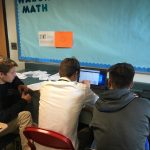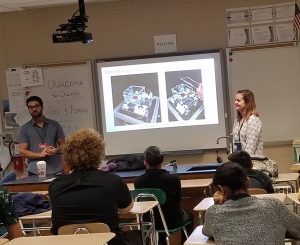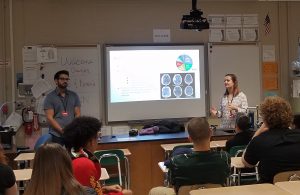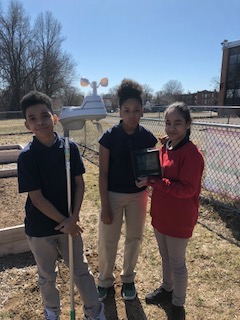August 28, 2014
This fall, 11 high school science and math teachers who took part in UConn’s Joule Fellows program will bring back to their schools in-depth knowledge on such topics as chemical-looping systems, 3-D printing and modeling of ocean waves.

The Joule Fellows outside the F.L. Castleman building
With their training in the program – formally known as Research Experience for Teachers (RET) – the teachers can now hold lessons on these specific engineering in a degree of detail rarely seen at the high school level. As part of the program, teachers from high schools, technical high schools, and community colleges come to UConn to do research for six weeks. They also meet every week for workshops on various topics and have a weekly lunch to exchange ideas. At the end of the program, they each present a short film about what they’ve learned and a lesson plan related to their experience. After the six-week period is over, the teachers stay in touch with their mentors.
Kazem Kazerounian, Dean of the School of Engineering, and Dr. Radenka Maric are the principal investigators of the program, which the National Science Foundation is funding for the second time.
The Joule Fellowship program is focused on outreach and immersing teachers from Connecticut high schools in engineering research. Past efforts to spark students’ interest in engineering include robot competitions at area high schools. During the most recent session, some of the Joule Fellows brought their students to their labs at UConn. Aida Ghiaei, program director, said this is the sort of initiative that strengthens the engineering community and the relationship between UConn and area schools.
The long-term goal is to reverse the ongoing decline in the number of U.S. citizens training to become engineers. State teachers work with faculty members in the Engineering School and learn proposal writing, technical communication, best engineering research practices, scientific ethics and code of conduct, among other subjects. They also train in techniques for creative problem-solving in the laboratory and learn how to develop these skills into effective lessons for their students.
It’s rare for high school science and math teachers to have formal engineering training, even though many colleges look to recruit promising students for their engineering programs.
“I teach high school chemistry and high school physics classes, and in both of those classes, I’m going to have what I’ll call ‘Fuel Cell Fridays,’” said Ruth Thomas, who teaches at Enfield High School. “They’re going to be learning what’s in a fuel cell, what it’s made of, they’re going to practice putting together models. By November, they’re going to come out and take a tour of C2E2 and some other engineering buildings – I’m going to bring about 90 students. They’ll be able to understand it at a much deeper level than they would have otherwise.”

Joule Fellow Peter Van Buren gives a presentation.
And because much of the training takes place in the laboratory, the program brings teachers beyond “textbook” science.
“They got to see things not working, which is very common in research,” said Travis Omasta, one of the post-doc students helping with the program. ”You have to figure out why it didn’t work, and then you move forward. That’s one of the most important components of research, and they got to see that first-hand with a couple frustrating moments.” Omasta is one 10 Joule Buddies, post-doc students who assist in the mentoring of the program.
Steve Pintavalle, who teaches at Glastonbury High School, agreed that observing the trial-and-error process of research will be valuable to his students.
“I think that’s something students don’t see,” he said. “They have this understanding that everything is supposed to go smoothly.”
Omasta said the benefits of the program work both ways.
“Whatever they’re doing is contributing to our research, and they’re learning a whole bunch of stuff along the way,” he said. “It ends up a positive experience the whole way, where everyone gets something out of it.”
Joule Fellow Peter Van Buren, who teaches at East Longmeadow High School, trained in the lab of Shalabh Gupta and learned about the science of building and operating copters.
“I think I have a better appreciation for the process you have to go through,” Van Buren said. “The physical building of the robot – anyone can do that, especially with a kit. But there’s all the stuff that goes on with the computer, the programming, the calibration, the firmware. I run a robotics club and that’s been very frustrating for a lot of the kids. I think having gone through the same process, that’s going to help me a lot in dealing with those issues.
Joule Fellows Faculty member Arash E. Zaghi (CEE) served as a mentor to Michael Humphreys, a math and science teacher at Xavier High School in Middletown, who’s completing his master’s degree in structural engineering. Zaghi said programs like this one are critical to the advancement of the future of engineering.
“By getting high school level educators into university laboratories to experience the most current practices in engineering, it enables them to share this experience with their students and in turn pass this excitement on to the next generation of engineers,” he said.





















